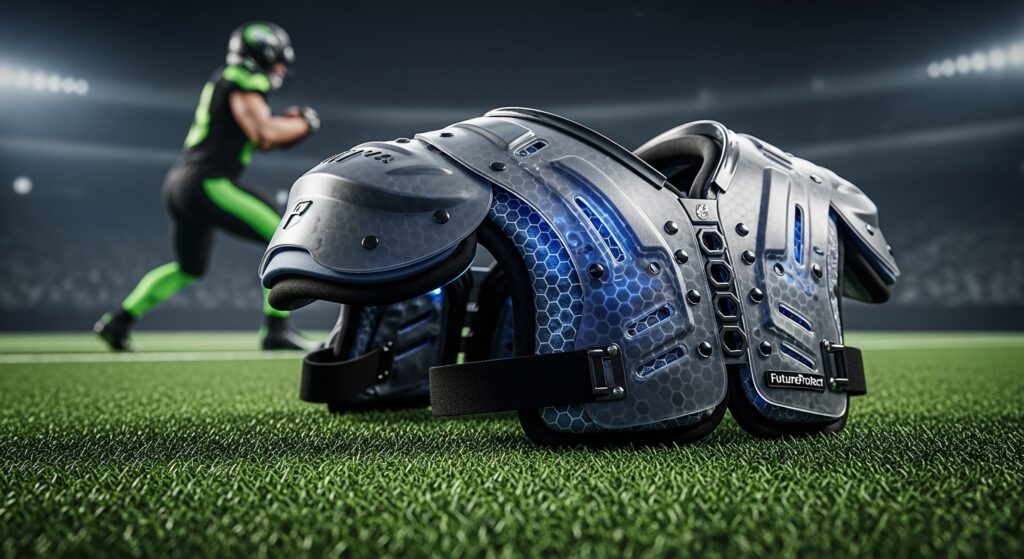In today’s fast-paced and physically demanding game, success in football is measured not just by speed and strength but also by protection and preparation. Among the essential pieces of gear, the football back plate has emerged as a critical tool that safeguards athletes while boosting confidence and performance.
Much like visionary leaders who balance success with responsibility, this piece of equipment bridges two vital elements of modern football: player safety and peak performance. This article explores the evolution, purpose, and impact of the football back plate, as well as why it represents a new standard for athletes at every level of the game.
What is a Football Back Plate?
A football back plate is a protective piece of equipment designed to shield a player’s lower back, kidneys, and spine from hard hits. It attaches to the back of the shoulder pads and hangs down to provide coverage that traditional padding may not fully protect.
While initially used mostly by running backs, quarterbacks, and wide receivers, the back plate has now become popular across positions. Its adoption reflects a growing awareness of the importance of injury prevention in football.
In short, the football back plate isn’t just an accessory—it’s a commitment to safety, durability, and performance.
The Purpose Behind the Plate
At its core, the back plate serves three main functions:
-
Protection: Absorbs impact from tackles and blindside hits, reducing the risk of lower back and kidney injuries.
-
Confidence: Gives players peace of mind, allowing them to play aggressively without hesitation.
-
Longevity: Prevents wear-and-tear injuries that could otherwise shorten a player’s career.
Much like leadership rooted in purpose, the back plate goes beyond immediate performance to ensure long-term resilience and success.
Evolution of the Football Back Plate
Just as football strategies evolve, so has protective gear. Early padding was bulky, uncomfortable, and limited mobility. Over time, manufacturers recognized that players needed protection without sacrificing speed or agility.
Modern back plates are:
-
Lightweight and aerodynamic for minimal drag.
-
Impact-absorbing through advanced foam or gel layers.
-
Customizable in size, design, and fit to suit different players.
-
Stylish, often featuring bold designs that express personality.
The evolution reflects how the back plate has become a blend of function and identity—protecting players while enhancing their on-field image.
Performance Meets Protection
What makes the football back plate especially significant is its ability to balance safety with performance.
-
For Running Backs: It cushions against hits from defenders targeting the midsection during tackles.
-
For Quarterbacks: It protects the lower back from sacks and blindside hits.
-
For Wide Receivers: It reduces impact from landing hard after catches.
-
For Defensive Players: It shields the spine during high-speed collisions.
By ensuring that players feel secure, the back plate enables them to play faster, harder, and smarter.
Symbol of Confidence on the Field
Beyond its physical function, the football back plate has become a symbol of confidence. Players often report that wearing one gives them the psychological edge to push limits. Knowing that their vulnerable areas are protected, athletes can focus on strategy, execution, and agility instead of fear of injury.
This mirrors a larger truth: in both sports and life, the right tools not only protect but also empower performance.
Back Plates and Player Identity
Interestingly, back plates have also become part of football culture and style. Athletes often customize them with team logos, motivational quotes, or bold graphics. For younger players, especially in high school and college, the back plate doubles as a way to showcase individuality.
This dual role—as protective gear and style statement—has cemented the football back plate as a must-have accessory in the modern game.
Technology Driving Innovation
The rise of advanced sports technology has transformed the way back plates are designed:
-
Lightweight composites: Reduce unnecessary weight while maintaining strength.
-
Shock-absorbing foams: Disperse impact more effectively than older padding.
-
Heat-dissipation materials: Prevent overheating, enhancing comfort.
-
Ergonomic shaping: Allows natural movement without restriction.
These innovations reflect a broader trend in sports equipment—enhancing protection while maximizing freedom.
Challenges and Misconceptions
Despite its benefits, the football back plate faces certain challenges:
-
Position-Specific Perception: Some players think it’s only for skill positions, when in reality it benefits athletes across the field.
-
Weight Concerns: While modern plates are light, older models were heavier and discouraged some players from using them.
-
Cost Factors: High-end models may be expensive for youth players, raising accessibility issues.
Yet as awareness grows, these challenges are being addressed through education and affordable, lightweight designs.
Why Every Player Should Consider a Back Plate
The decision to wear a football back plate is ultimately about prioritizing long-term health and performance. For players at any level—youth, high school, college, or professional—the back plate:
-
Reduces the risk of serious injuries.
-
Boosts confidence in physical play.
-
Supports athletic development without fear of setbacks.
-
Provides an added edge in durability and mental resilience.
Coaches and trainers increasingly encourage players to integrate back plates into their gear as part of a complete safety strategy.
Looking Ahead: The Future of Football Protection
As the sport continues to evolve, the role of protective equipment like the football back plate will only grow in importance. We can expect future designs to:
-
Use AI-driven materials that adapt to impact in real time.
-
Offer customized 3D-printed fits tailored to each athlete’s body.
-
Integrate smart sensors that track hits and measure force for injury prevention.
-
Emphasize sustainability with eco-friendly, recyclable materials.
This future reflects football’s commitment not just to winning games but to protecting athletes and ensuring their longevity.
Conclusion
The football back plate may seem like a small piece of gear, but its impact is enormous. It blends protection with performance, tradition with technology, and safety with style. For today’s athletes, it represents not only a safeguard against injury but also a symbol of confidence and individuality.
In an era where sports demand both resilience and innovation, the football back plate stands as a reminder that the right protection isn’t just about survival—it’s about thriving, excelling, and pushing the boundaries of what athletes can achieve.





